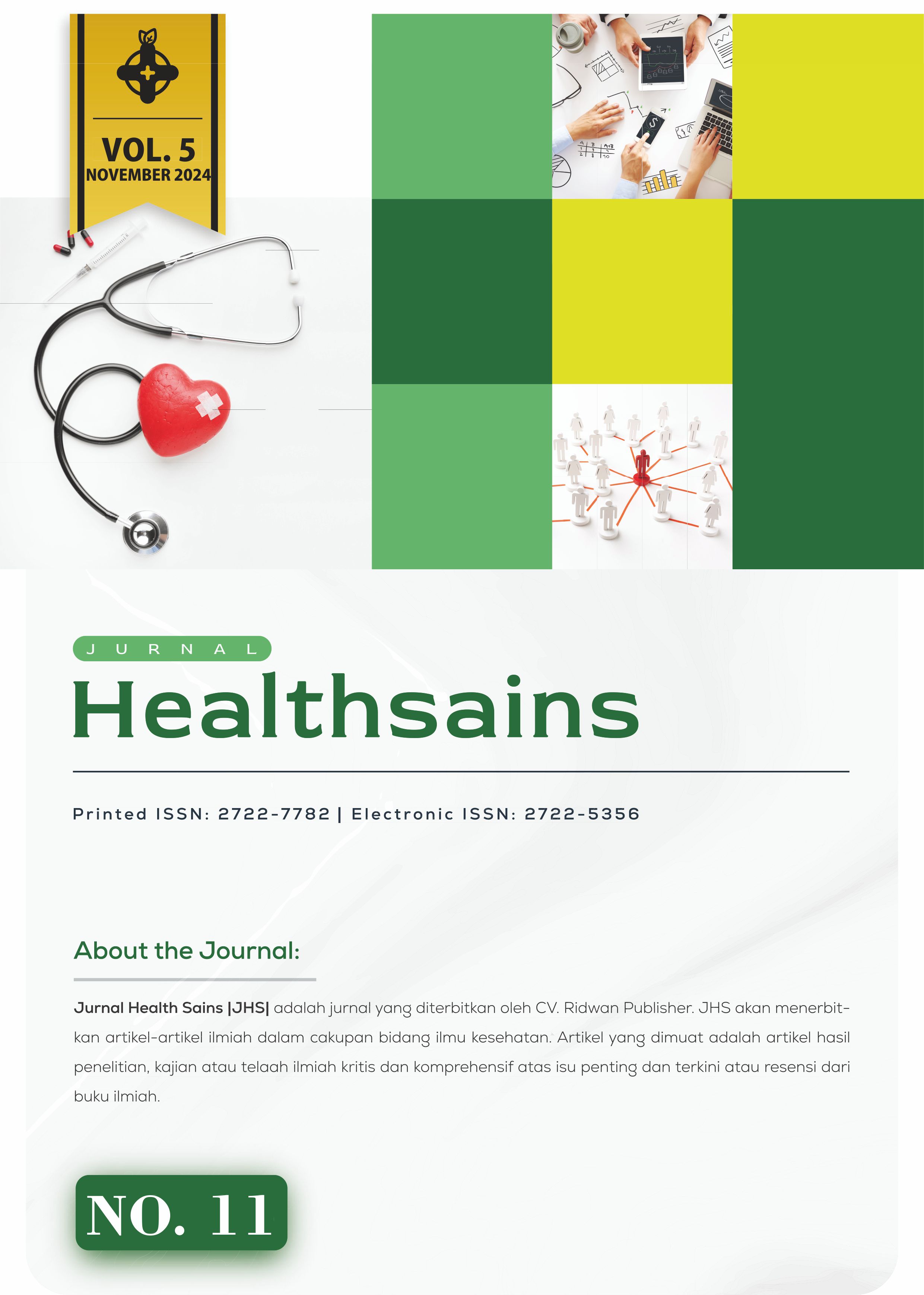Risk Factors of Intrauterine Fetal Death in Cipto Mangunkusumo General Hospital, Indonesia
DOI:
https://doi.org/10.46799/jhs.v5i11.1394Keywords:
Intrauterine, fetal death, risk factorAbstract
Intra Uterine Fetal Death ( IUFD ) results from various disorders of the mother, fetus, and placenta. This study aimed to explore factors contributing to IUFD, knowing the risk factors will prevent this case in the future time. In 2016-2018, patients diagnosed with IUFD at 22 weeks of gestation were included. One hundred twenty-five patients with IUFD and 125 controls with alive fetuses were enrolled. Data were collected from the medical records of participants. Factors that may have contributed to IUFD were explored. Comparisons between various risk factors and outcomes of the two groups were made. P-value was statistically significant if ≤0.05. We found several factors that contribute to IUFD. Some factors like BMI, ANC provider, referred from tertiary health facility, and congenital anomaly increased the risk of IUFD by 2.86, 5.86, 6.26 and 9.45 times respectively. In contrast, some factors like a number of ANC ≥ 6 times and gestational age >36 weeks decrease the risk of IUFD. Regular and intensive ANC ≥ 6 times during pregnancy, number of pregnancy and gestational age ≥ 36 weeks significantly decreases the risk of IUFD with OR 0.12, 0.4, and 0.23 respectively. High-quality ANC to identify IUFD risk factors may lead to a significant decrease in its occurrences. Some factors like BMI, ANC provider, referred from tertiary health facility, and congenital anomaly increased the risk of IUFD, but Number of ANC≥ 6 times, number of pregnancy ≥2 and gestational age ≥36 weeks can reduce risk of IUFD.
References
Beauclair, R., Petro, G., & Myer, L. (2014). The association between timing of initiation of antenatal care and stillbirths: a retrospective cohort study of pregnant women in Cape Town, South Africa. BMC Pregnancy and Childbirth, 14, 1–10. https://doi.org/doi:10.1186/1471-2393-14-204
Blencowe, H., Cousens, S., Jassir, F. B., Say, L., Chou, D., Mathers, C., Hogan, D., Shiekh, S., Qureshi, Z. U., & You, D. (2016). National, regional, and worldwide estimates of stillbirth rates in 2015, with trends from 2000: a systematic analysis. The Lancet Global Health, 4(2), e98–e108. https://doi.org/https://doi.org/10.1016/S2214-109X(15)00275-2
Divya, B., Ashwini, N. U., & Asha, S. O. V. (2015). A study of intrauterine fetal death in a tertiary care hospital. Int J Reprod Contracept Obstet Gynecol, 4(6), 2018–2031.
Fernando, S., Bandara, T., Sathanantharajah, R., & Withanaarachchi, K. (2014). Pattern of clinically recognisable congenital malformations in babies born in a tertiary referral centre in Sri Lanka. Ceylon Medical Journal, 59(4).
Harmon, Q. E., Huang, L., Umbach, D. M., Klungsøyr, K., Engel, S. M., Magnus, P., Skjærven, R., Zhang, J., & Wilcox, A. J. (2015). Risk of fetal death with preeclampsia. Obstetrics & Gynecology, 125(3), 628–635. https://doi.org/doi:10.1097/AOG.0000000000000696
Johnson, C. T., Farzin, A., & Burd, I. (2014). Current management and long-term outcomes following chorioamnionitis. Obstetrics and Gynecology Clinics, 41(4), 649–669. https://doi.org/doi:10.1016/j.ogc.2014.08.007
Kc, A., Nelin, V., Wrammert, J., Ewald, U., Vitrakoti, R., Baral, G. N., & Målqvist, M. (2015). Risk factors for antepartum stillbirth: a case-control study in Nepal. BMC Pregnancy and Childbirth, 15, 1–10.
Leal, M. do C., Esteves-Pereira, A. P., Viellas, E. F., Domingues, R. M. S. M., & Gama, S. G. N. da. (2020). Prenatal care in the Brazilian public health services. Revista de Saúde Pública, 54, 8.
Liu, L.-C., Wang, Y.-C., Yu, M.-H., & Su, H.-Y. (2014). Major risk factors for stillbirth in different trimesters of pregnancy—A systematic review. Taiwanese Journal of Obstetrics and Gynecology, 53(2), 141–145.
Liu, Y., Wang, X., Zou, L., Ruan, Y., & Zhang, W. (2017). An analysis of variations of indications and maternal-fetal prognosis for caesarean section in a tertiary hospital of Beijing: A population-based retrospective cohort study. Medicine, 96(7), e5509. https://doi.org/doi:10.1097/MD.0000000000005509
MacDorman, M. F., & Gregory, E. C. W. (2015). Fetal and perinatal mortality: United States, 2013.
Man, J., Hutchinson, J. C., Heazell, A. E., Ashworth, M., Levine, S., & Sebire, N. J. (2016). Stillbirth and intrauterine fetal death: factors affecting determination of cause of death at autopsy. Ultrasound in Obstetrics & Gynecology, 48(5), 566–573. https://doi.org/doi.org/10.1002/uog.16016
Maslovich MM, B. L. (2020). Intrauterine Fetal Demise. StatPearls Publishing. https://www.ncbi.nlm.nih.gov/books/NBK557533/
Yao, R., Ananth, C. V, Park, B. Y., Pereira, L., Plante, L. A., & Consortium, P. R. (2014). Obesity and the risk of stillbirth: a population-based cohort study. American Journal of Obstetrics and Gynecology, 210(5), 457-e1.
Downloads
Published
Issue
Section
License
Copyright (c) 2024 Junita Indarti, Syifa Mardhatillah, Kristian Alda, Arresta Vitasatria, Affan Solihin, Ganot Sumulyo, Muhammad Ikhsan, Mohammad Agassi Antoniman

This work is licensed under a Creative Commons Attribution-ShareAlike 4.0 International License.
Authors who publish with this journal agree to the following terms:
- Authors retain copyright and grant the journal right of first publication with the work simultaneously licensed under aCreative Commons Attribution-ShareAlike 4.0 International (CC-BY-SA). that allows others to share the work with an acknowledgement of the work's authorship and initial publication in this journal.
- Authors are able to enter into separate, additional contractual arrangements for the non-exclusive distribution of the journal's published version of the work (e.g., post it to an institutional repository or publish it in a book), with an acknowledgement of its initial publication in this journal.
- Authors are permitted and encouraged to post their work online (e.g., in institutional repositories or on their website) prior to and during the submission process, as it can lead to productive exchanges, as well as earlier and greater citation of published work.






